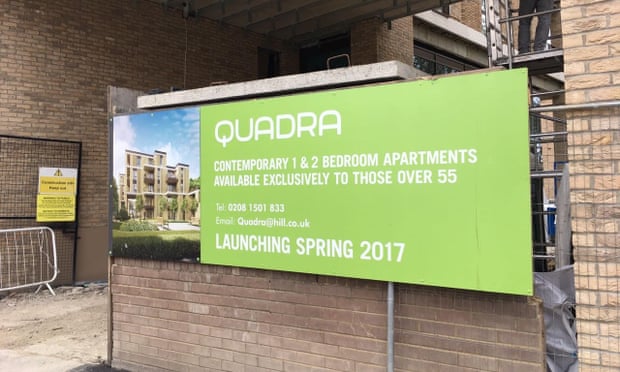As the weekends warm up, east Londoners are descending in their masses on London Fields, a park that has earned a reputation as the epicentre of gentrification in the borough of Hackney. The barbecues, daytime drinking and marijuana haze are as predictable as the media sniffing over the “drunken hipsters and thoughtless brats” who take over the park in droves.
But if that’s all standard operating procedure for the beginning of summer in the city’s hippest neighbourhood, something altogether newer has arrived on the park’s western edge. It’s called Quadra, and it’s a housing development available exclusively to residents aged 55 and over.
The contemporary, airy-looking building is a “downsizer home” – housing aimed at baby boomers who no longer need a large family home in the suburbs, but have both the capital and desire to relocate to sought-after locations in the city.
“It’s an aspirational product,” says Claire Anderson, director of development for Hanover, the housing association behind Quadra. “We make no assumptions about retirement at the age of 55. ‘Downsizer’ simply describes what people are aiming to do, usually when children have grown up and left home, and they’re freeing up money held in equity and property to do other things with. This offer is just far better future-proofed.”
What isn’t future-proofed, of course, is the housing situation of the younger Londoners who have made London Fields such an attractive place to live in the first place. It’s certainly easy to see why an older couple might want to move into a two-bed flat at Quadra. The neighbourhood is vibrant, walkable and full of youthful energy. What’s less apparent to twentysomething Hackney local David East, is why younger people are being deliberately excluded – not just from the more expensive private ownership flats, but also from the 14 “affordable” housing flats being offered for less than 80% of market rent.
“I don’t think it’s fair,” East says. “Imagine if [Quadra] was limited to under 35-year-olds? People would certainly have a problem with that. People I know are trying to rent houses around this area, as it’s obviously a cool area, and it’s quite difficult to find affordable rent. It should be open to letting anyone rent there.”
In the midst of London’s housing crisis, many agree that the capital needs a diverse range of new-builds to meet the soaring demand. And there is already a long tradition of providing dedicated housing to the elderly, dating back to the charitable almshouses of medieval times – which is partly why Part 4 of the Equality Act 2010, regarding housing, makes it legal to discriminate based on age (where it wouldn’t be on race or gender).
Although Hanover is a housing association that specialises in serving elderly and retirement-aged populations, Quadra and its three other downsizer homes are not care homes. Bike racks adorn the breezy outdoor space at Quadra, and a press officer mentions selling points such as Broadway Market and London’s only Olympic-sized heated outdoor pool, just a stone’s throw away. Other than being built to mobility standards (for example, wider corridors and doorways, and lower window sills), and having a superintendent on site to arrange repairs, Hanover stresses these flats are “not care ready”.
Anderson says their target demographic is not necessarily even retired, let alone vulnerable. Rather, they are people who are “moving through choice, not circumstances”. She adds that building such a development at the centre of a lively, occasionally raucous area such as London Fields is intentional, and argues that Quadra is a way to “redress the balance” of Hackney’s gentrification and create a more heterogeneous community. (With a price range of £725,000 to £810,000 for a two-bed flat, the heterogeneity won’t necessarily extend to economic status.)
In a case study provided by Hanover, a couple who moved from a four-bedroom home in Highbury to the downsizer property Woodside Square in Muswell Hill did so precisely for the community that surrounded it – the very place where they had raised their children 20 years prior.
“What really attracted us to Woodside Square was the lovely garden outlook, concierge service, and like-minded neighbours,” says Valerie Richards, 81. “We wanted to live somewhere that was familiar, and you cannot get any more familiar than just around the corner from where we raised our children. This development really ticked all the boxes for us.”
The central economic argument for downsizer homes is twofold. They provide for an untapped demographic in the housing market: the post-children, pre-retirement “third agers”. And they also free up larger homes which can be used by younger, growing families who need more space.
A Sheffield University project called Dwell (Designing for Wellbeing in Environments for Later Life) from 2016 notes that there are already 20 million households in the 55-and-over category, and a forecasted doubling of the number of Britons over 85 in the next two decades. As a result, it said, the blanket term of “older person housing” has become “inadequate to describe the breadth of expectations and aspirations for later life”.
But some say the placement of Quadra in an area where younger generations struggle to find affordable housing misses the bigger picture. According to Seb Klier, a campaign manager with Generation Rent, this kind of preferential treatment for an older, economically privileged demographic is symptomatic of London’s housing mistakes.
“Because London is a massive city, you can make the case for any housing type if you want to,” Klier says. “But you have to think about priorities. Is this really where we want to be going? Or do we want genuinely affordable social housing and shared ownership that’s targeted at first-time buyers?”
The biggest decline in homeownership in the UK is among 30-34 year olds. They have seen a 7.2% drop since 2011, to just above 40%. The highest rate remains among the over-55s, holding steadfastly above 70% – though this has declined overall, in keeping with national trends
It is true that there are a few housing schemes in London catering to younger demographics – including Pocket, which sells basic housing to first-time buyers who fall under the Greater London Authority income cap, and the Sadiq Khan-endorsed “Naked Homes” initiative, which offers intentionally under-outfitted new flats to minimalism-loving millennials for 40% less than new-builds.
But, unlike Quadra – which requires at least one occupier in each flat to be older than 55 – these developments don’t have a stated age restriction. Their demographic simply skews younger as a byproduct of the smaller living spaces and stripped-down facilities they offer.
Branded downsizer housing remains niche for now, although other private developers, including McCarthy and Stone and Barratt Homes, seem to be tapping into the clear economic opportunity they represent. Even Quadra is a private-public partnership with the developer Hill: downsizing obviously represents a commercial opportunity to private developers, not just socially motivated housing associations.
Malcom Tait, an urban planner and co-author of the Dwell report, describes London as being on the “vanguard” of this trend. But he also urges developers and planners to create downsizer homes in locations that better balance the desires of the residents and the locals.
“When we talked to older people, many were quite keen on the idea of city centre living, but they generally tend to say ‘we don’t live next door to students’ or ‘we want to live in a slightly quieter area’,” says Tait. “Perhaps it’s about saying: OK, we want to build these in very accessible locations, but what about doing it in slightly quieter zone?”
For now, Quadra is open for business. Only time will tell how the new residents will respond next time the younger denizens of London Fields leave the park “looking like a warzone”.
Follow Guardian Cities on Twitter and Facebook to join the discussion, and explore our archive here




